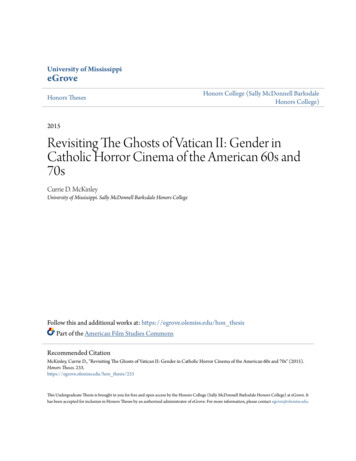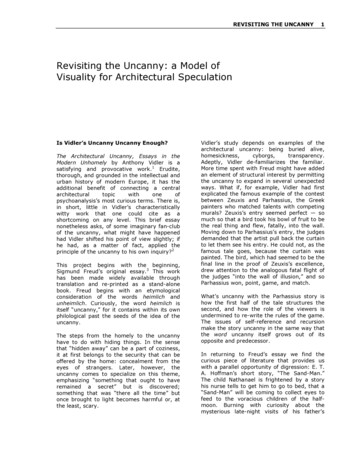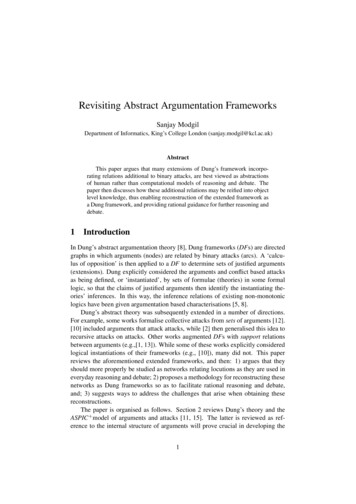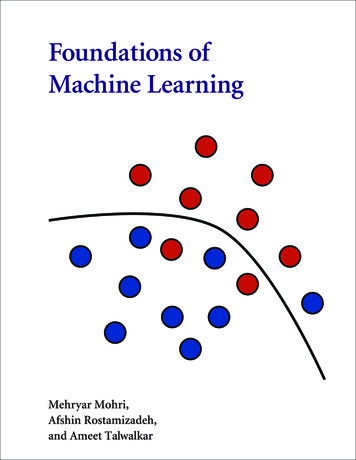
Transcription
University of MississippieGroveHonors ThesesHonors College (Sally McDonnell BarksdaleHonors College)2015Revisiting The Ghosts of Vatican II: Gender inCatholic Horror Cinema of the American 60s and70sCurrie D. McKinleyUniversity of Mississippi. Sally McDonnell Barksdale Honors CollegeFollow this and additional works at: https://egrove.olemiss.edu/hon thesisPart of the American Film Studies CommonsRecommended CitationMcKinley, Currie D., "Revisiting The Ghosts of Vatican II: Gender in Catholic Horror Cinema of the American 60s and 70s" (2015).Honors Theses. 233.https://egrove.olemiss.edu/hon thesis/233This Undergraduate Thesis is brought to you for free and open access by the Honors College (Sally McDonnell Barksdale Honors College) at eGrove. Ithas been accepted for inclusion in Honors Theses by an authorized administrator of eGrove. For more information, please contact egrove@olemiss.edu.
Revisiting The Ghosts of Vatican II:Gender in Catholic Horror Cinema of the American 60s and 70sCurrie Dixon McKinleyA thesis submitted to the faculty of The University of Mississippi in partial fulfillment ofthe requirements for completion of the Sally McDonnell Barksdale Honors College.The University of MississippiOxford MSSpring 2015ApprovedAdvisor: Dr. Mary F. ThurlkillReader: Dr. Caroline WiggintonReader: Dr. Robert Barnard
2015Currie Dixon McKinleyALL RIGHTS RESERVEDii
DEDICATIONFor Harry, E. Buzz, Abby, Sadie, Bugsy, and all the other movies dogs who were farsmarter than their owners.iii
ABSTRACTCURRIE MCKINLEY:Revisiting The Ghosts of Vatican II:Gender in Catholic Horror Cinema of the American 60s and 70s(Under the direction of Dr. Mary F. Thurlkill)This thesis contextualizes 1960s and 1970s American horror films against the historicalbackdrop of Vatican II with the intent of discovering how the texts, reception, andlegacies of the films could illuminate the gender politics of the various changesimplemented over the course of Vatican II. The first chapter analyzes the text ofRosemary’s Baby as a metaphor for restrictive policies on birth control on the part of thepost-Vatican II papacy. The second chapter considers the implications of disagreementsbetween the author and director of The Exorcist with regard to how different individualswanted the Catholic Church to present itself in Vietnam-era America. The third and finalchapter analyzes the legacy of The Amityville Horror as the end of the Catholic horrorrenaissance and the beginning of the more female-friendly paranormal horror genre.iv
TABLE OF CONTENTSINTRODUCTIONWhy this project?1Why these films?4CHAPTER IRoe’s Mary: Rosemary’s Baby and “Satanic” Catholic Conservatism7CHAPTER IIA Failed Exorcism: The Exorcist and Lingering Ghosts of Catholic Conservatism26CHAPTER IIIThe End of an Era and The Beginning of a New Age: The Legacy of TheAmityville Horror49CONCLUSION63BIBLIOGRAPHY64v
INTRODUCTION Why this project?This project began, as many do, with an observation rather than a question. Aburgeoning horror junkie, I had spent the past few months rewatching some of mypersonal favorite scary movies in the company of friends and family whose arms I hadtwisted into sharing my terror – Paranormal Activity 1 and 3 and The Conjuring were inheavy circulation. This fascination came to the dismay of my friends and parents, whorespectively found the movies laughably unscary and repellently distasteful. However, Iinsisted on watching them over and over with them, partially because without mypresence they would wheedle their way out of watching, but more so because Icontinually grappled with the implications of the gendered tropes I saw on screen. Threeseparate films with nine total daughters between them and no sons to speak of, threewomen who became possessed and no men. Most specifically, I gravitated towards TheConjuring and its implementation of religion. Whereas the women possessed in theParanormal films exhibited very little agency throughout the process of becomingpossessed, the mother in The Conjuring, with the help of another woman—a woman of1
God—was able to overcome her possession through the power of divine motherly love.Their respective husbands were both sidelined for the film’s climax, despite the men’sclear position as heads of household iterated in the film. At this point, a question began toform – did more religiously inflected horror films have a tradition of affording femalecharacters a heightened level of agency within the framework of Christianity? To whatend I asked this question, I was uncertain, but that initial spark of curiosity led me back toAmerican cinema’s horror renaissance – the Catholic possession films of the 1960s and70s.To my dismay, my suspicions of female empowerment in horror films influencedby Christianity were far from confirmed. In Rosemary’s Baby I saw an otherwise strongwoman coerced into bearing the Anti-Christ and finally deciding to be that child’smother. In The Exorcist I saw a young girl become possessed, her body used continuallyas a plot device to measure the spiritual strength of her male saviors while her motherstood by in terror. In The Omen, I saw a maid hang herself, a mother be thrown from ahospital window, and the only competent female character, the Antichrist’s satanic aupair, be stabbed to death by Gregory Peck. Finally, and almost most upsettingly, in TheAmityville Horror, I watched as directors paraded the Christian mother figure around infetishizing pigtails, preppy schoolgirl outfits, and satin soft-core lingerie as she watchedher husband slowly become unhinged before his sudden recovery in the film’s final act,in which he returns to patriarchal grace through the heroic act of not killing his wife andchildren. How could The Conjuring, a film whose marketing and critical acclaim hingedheavily on its roots in the 70s tradition of Catholic horror cinema, have crafted such apositive representation of Christian female agency from an era of filmmaking with such2
regressive portrayals of women? My research led me inevitably to the scholar CarolClover and various other feminist critics of horror, but despite all my searching, I couldfind very little scholarship on these 60s and 70s texts that contextualized them against thespecific historical-religious backdrop of their moment – against Vatican II, the definingevent of Catholicism in the 20th century from which fascination with these religiouslyinflected horror classics sprung.The further I looked into the specifics of Vatican II—the changes it made to theCatholic Church, the gendered aspects of the proceedings which were all but inevitablegiven the event’s proximity to the women’s movement, the complete overhaul of how theChurch claimed it wanted to be perceived in the modern world—the more the themes ofthese 60s and 70s horror films crystallized in my head. I began to see some of the films asoperating subversively, critiquing the Church’s shortcomings in living up to the promisesof Vatican II. Some began to appear more celebratory of the Church, advocating for itscontinued progress towards a more modernized, more approachable brand of faith. Allthe films, however, have a singular confusion with incorporating gender into theircommentaries on Catholicism and its growing pains in the years immediately followingVatican II – are women a concern? Does a new model of Catholicism necessitate a newbrand of Christian masculinity? Do women still fit comfortably in a Holy Motherarchetype in an increasingly progressive era, and does their existence outside thatarchetype make them powerful? Threatening? Disposable? All these questionsculminated into the final research intervention from which this project stems – How didthe texts of these films and their interactions with American audiences reveal publicperceptions of post-Vatican II Catholicism’s trajectory with regard to gender? The3
question bears scrutiny in this moment not only because of the upcoming 50th anniversaryof Vatican II (as fate would have it, my birthday this coming December 9th will mark fiftyyears to the day of human existence in a post-Vatican II world), but because of films likeThe Conjuring and The Exorcism of Emily Rose that show religion is having a resurgencein mainstream, fiscally successful horror film. As we look forward to religiously inflectedhorror film of the future and its capacity for positive and provocative genderrepresentation, we would do well to look towards the past to see what contemporary filmshave to draw upon, and what has changed with regard to intersections of religion andgender between then and now.Why these films?The question of cherry picking is nearly irrelevant to scholarship on post-VaticanII American horror cinema, as there are really only four contenders if one wants toexplore the films that, by the numbers, were most widely seen and had the largest impacton their cultural moments. The films this paper will interrogate proceed in chronologicalorder - Rosemary’s Baby (1968), The Exorcist (1973), and The Amityville Horror (1979).Before delving into how each of these movies will be implemented in this project, I feelthe need to account for why The Omen (1976), a traditional companion to Rosemary andExorcist given that the three are often informally referred to as the demonic child trilogy,does not appear prominently in the following chapters. While The Omen clearly has anenduring cultural presence (a nearly shot for shot remake was released in 2006) andemploys horror conventions that compliment both Rosemary and Exorcist, its totaldomestic gross of sixty million was vastly outpaced by Amityville, which pulled in4
eighty-six million despite being by most other conceivable measures a worse film.Because Amityville arrived just on the cusp of the 80s and concerns itself so specificallywith the legacy of Vatican II, it seemed an altogether better choice for this project thanThe Omen, especially given of how important the films’ interactions with their audiencesin terms of sheer viewer volume are to some of my central arguments (IMDB).The first chapter on Rosemary Baby is less concerned with reception and audienceinteraction than it is with the text of the film itself. Rosemary’s most salient offeringswith regard to gender in post-Vatican II America come in the form of the metaphoricpotential of the text – the symbolic criticisms that its characters make of instances inwhich the Catholic Church back-paddled on its promises of progressivism after Vatican IIwith regard to Catholic women and their right to bodily autonomy.The second chapter deals with The Exorcist, a film which I use not so much forthe text itself as for the ways in which issues over the production and reception of the textrevealed a divide in how different people wanted the Church to represent itself inVietnam-era America. While some celebrated the promises of progressivism made duringVatican II and wanted to see Church patriarchs carry out those promises by modeling agentler, less traditionally conservative brand of masculinity, many others seemed contentto leave the promises of Vatican II by the wayside in favor of a more traditional, archaicform of religiosity and Christian manhood.The third and final chapter on The Amityville Horror is about the legacy themovie left behind. In many ways, Amityville marks a transition from America’sfascination with Catholicism to its foray into more pseudo-scientific styles ofsupernatural horror. The manner in which Amityville makes this transition sets up a5
number of gendered tropes that speak both to how Americans perceived women’s roles asbeing limited with regard to religious cinema, and augmented with regard to the NewAge genre of horror cinema that took off immediately following the wild success ofAmityville.Through an assessment of these films—their central metaphors, interactions withtheir audiences, and contemporary legacy given our fifty-year vantage point from whichto view them—this project will argue that although progressive changes made duringVatican II certainly impacted the inner workings of The Church in ways that still existtoday, those changes did not carry over into how Catholicism regarded traditionalAmerican gender constructs – a fact which ultimately limited the Church’s influence incontemporary cultural spheres as public interest waned on an institution that did not seemto be progressing in the ways that Vatican II had promised.6
CHAPTER IRoe’s Mary: Rosemary’s Baby and “Satanic” Catholic Conservatism On the morning of July 25th 1968, the Vatican released an encyclical letter to theCatholic world reaffirming orthodox teachings on conjugal love, birth control, andparenthood. Entitled Humanae Vitae, Latin for “Of Human Life,” the letter respectivelystated that “marriage and conjugal love are by their nature ordained toward theprocreation and education of children,” that “the direct interruption of the generativeprocess [ ] and, above all, all direct abortion [ ] are to be excluded as lawful means ofregulating [a family’s] number of children,” and that responsible parents “are not free toact as they choose” but “are bound to ensure that what they do corresponds to the will ofGod the Creator” (4-5). These declarations, spearheaded by Pope Paul VI, causedimmediate controversy in Catholic communities, with the August 7th National CatholicReporter bearing the headline: “Paul Issues Contraceptive Ban: Debate Flares on HisAuthority” (McCormick). Though the Church had steadfastly maintained the positions7
explicated in Humanae since the 1930 encyclical letter Casti Connubii, the letter came asa shock to Catholic leaders and practitioners alike because of recent declarations made bya group known as the Pontifical Commission on Birth Control (Kissling). Created in 1963after the Second Vatican Council’s failure to reach a decision on the morality of modernforms of birth control, the commission was an assemblage of Papal appointed scien
Amityville Horror, I watched as directors paraded the Christian mother figure around in fetishizing pigtails, preppy schoolgirl outfits, and satin soft-core lingerie as she watched her husband slowly become unhinged before his sudden recovery in the film’s final act, in which he returns to patriarchal grace through the heroic act of not killing his wife and children. How could The Conjuring .











